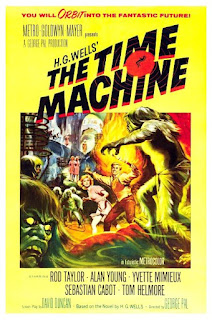The Time Machine (1960)
Event films were what Hollywood produced before the modern blockbuster cycle set in. While many movies - even A-list ones - were black and white dramas, westerns and war pictures, there would be those epics that would get the full studio backing. The best ones have stood the test of time, and most of them are major Stanley Kubrick or David Lean productions spanning hours of story and beautiful locations.
Science fiction movies, like the literature that inspired them, seldom received the same treatment. There would occasionally be a major studio attempt like This Island Earth or Forbidden Planet that would receive a bit more funding than the normal Saturday matinee fare, but in the mind of most critics science fiction was for children. That is perhaps why George Pal was able to produce some of the most memorable science fiction and fantasy films of the 1950s and 1960s. He began making children's shorts, but often with complex animation that lent well to special effects heavy films such as The War of the Worlds, which Pal had produced. While that gave us an update of one of H.G. Wells's most popular tales, it is outshined by another Wells adaption, 1960's The Time Machine.
An inventor named George (Rod Taylor) asks that his group of friends meet him for dinner on January 8, 1900. George arrives late, his clothes in tatters and looking exhausted. He proceeds to tell them the tale of how he used his full-sized working model of a time machine, the miniature of which he had shown them a week prior, to travel to the future. In doing so he traverses through both world wars and into 1966, just in time for London to be destroyed by bombs launched from atomic satellites which cause a volcanic eruption, covering the city for millennia.
The traveler goes forward, eventually released from the mountain, to see a brand new world arise around him. Coming to a stop nearly 800 thousand years from his starting point he beholds what at first appears to be a paradise, with a group of childish humans living a life of leisure among ruined buildings. After he rescues a girl named Weena (Yvette Mimieux) from drowning he begins to learn much of what has happened to humanity. Those that retreated underground during wars that had made the Earth unlivable had devolved into creatures called Morlocks, while the Eloi, the surface dwellers, have become their cattle.
Wells was a socialist and The Time Machine had intentional references to the struggles between the workers and the elite, presenting the world of the Eloi and Morlocks as the ultimate end of the class struggle. It was also written in 1895. While Wells had a great imagination he didn't imagine what the first half of the 20th century would bring. Itt was written at a time when most wars were ongoing skirmishes that still involved the spread of the empires. The movie's contemporary time is the first week of January of 1900, and Pal and writer David Duncan revised much of the history from the book to fit the actual history of the world up to their time. It still maintains some of the book's pessimism, showing our current civilization being destroyed a mere six years after the release of the film.
Pal wanted the movie to be a prestige picture, and a lot of money went into the effects. Some still hold up. The destruction of London doesn't, as the miniatures and the cars used look too much like toys. The actual sets in the future, as well as excellent blending of matte paintings, are much better, including the Morlocks' world where machines constantly produce whatever they were meant to and their tenders having little knowledge beyond how to work them by instinct. The makeup on them is astounding as well, with an effective scene of their reflective eyes suddenly appearing all around our hero. The other iconic design is that of the machine, with the design for this movie becoming the basis for most other movies based on it.
Rod Taylor makes for a good hero as well as a believable scientist, since the Traveler in the book, like most of Wells's narrators, wasn't elaborated on much. We do get a voice of reason in one of George's contemporaries, David Filby (Alan Young), who also plays his offspring in later encounters as the traveler moves into the future. The rest of the group is the usual bunch of stuffy British gentlemen harumphing, and it does take a while for the story to get going because of it. When it does, despite some of the effects showing their age, it is still just as wonderful as when I first saw it as a kid. Yes, the book is much better, but this is the best version that has been brought to the big screen, or most likely ever could.
The Time Traveler (1960)
Time: 103 minutes
Starring: Rod Taylor, Yvette Mimieux, Alan Young
Director: George Pal




I was reading on Facebook today that Pal was such a fan of Woody Woodpecker that he'd have a Woody cameo in most of his movies. In this one I guess a little girl drops a Woody doll during the London bombing scene.
ReplyDelete